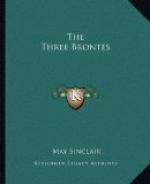But in Villette there are none of these battlings and rendings, these Titanic upheavals and subsidences. Charlotte Bronte’s imagination, and her sense of the real, are in process of fusion. There are few novels in which an imagination so supreme is wedded to so vivid a vision of actuality. It may be said that Charlotte Bronte never achieved positive actuality before. The Pensionnat de Demoiselles is almost as visibly and palpably actual as the Maison Vauquer in Pere Goriot. It is a return to the method of experience with a vengeance. Charlotte’s success, indeed, was so stunning that for all but sixty years Villette has passed for a roman a clef, the novel, not only of experience, but of personal experience. There was a certain plausibility in that view. The characters could all be easily recognized. And when Dr. John was identified with Mr. George Smith, and his mother with Mr. George Smith’s mother, and Madame Beck with Madame Heger, and M. Paul Emanuel with Madame Heger’s husband, the inference was irresistible: Lucy Snowe was, and could only be, Charlotte Bronte. And as the figure of M. Paul Emanuel was ten times more vivid and convincing than that of Rochester, so all that applied to Jane Eyre applied with ten times more force to Lucy. In Villette Charlotte Bronte was considered to have given herself hopelessly away.
I have tried to show that this view cannot stand before an unprejudiced examination of her life and letters. No need to go into all that again. On the evidence, Charlotte seems at the best of times to have fallen in love with difficulty; and she most certainly was no more in love with “the little man”, Paul Emanuel, than she was with “the little man”, Mr. Taylor. The really important and interesting point is that, if she had been, if he had thus obtained the reality with which passion endows its object, her imagination would have had no use for him; its work would have been done for it.
To the supreme artist the order of the actual event is one thing, and the order of creation is another. Their lines may start from the same point in the actual, they may touch again and again, but they are not the same, and they cannot run exactly parallel. There must always be this difference between the actual thing and the thing drawn from it, however closely, that each is embedded and enmeshed in a different context. For a character in a novel to be alive it must have grown; and to have grown it must have followed its own line of evolution, inevitably and in its own medium; and that, whether or not it has been “taken”, as they say, “from life”. The more alive it is the less likely is it to have been “taken”, to have been seized, hauled by the scruff of its neck out of the dense web of the actual. All that the supreme artist wants is what Charlotte Bronte called “the germ of the real”, by which she meant the germ of the actual. He does not want the alien, developed




